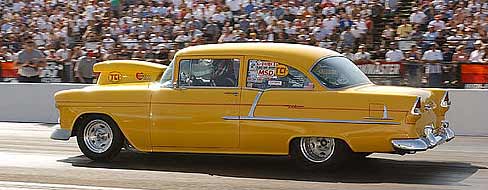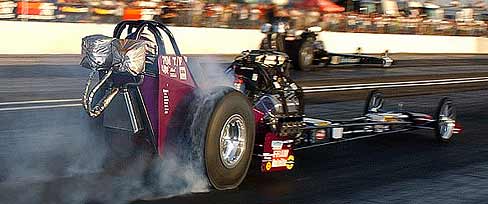
With Marc Meadors
Innerview By Darr Hawthorne
3-17-04
A lot of Vintage Drag Racing associations have come and gone in the last few years, but one that has survived is the Goodguys Rod and Custom Association.
 Founded
in 1986 by Gary Meadors and located in the East Bay town of Alamo, California,
Goodguys is the nation's leader in producing and promoting events for the hot
rodding, vintage drag racing and automotive enthusiast. With approximately 66,000
worldwide members, Goodguys will stage 23 car shows and five Vintage Drag Racing
meets in 2004.
Founded
in 1986 by Gary Meadors and located in the East Bay town of Alamo, California,
Goodguys is the nation's leader in producing and promoting events for the hot
rodding, vintage drag racing and automotive enthusiast. With approximately 66,000
worldwide members, Goodguys will stage 23 car shows and five Vintage Drag Racing
meets in 2004.
Our west coast editor Darr Hawthorne spoke with the Goodguys President prior to the 45th Annual March Meet to talk about the state of Vintage Drag Racing today.
DRO: What's the state of Goodguys VRA today?
M: Well, financially it's not a winner, but our motivation and our enthusiasm for it is over the top. That's why we keep on trucking, keep on going on, you know? We have one big successful March meet and the rest of the events kind of feed off that. At the end of the year our accountants come in and say, "why are you guys doing this? Why do you do these drag races?" 'Cause we love it; it makes us different. We have tons of friends and family that are involved with it and we're just going to continue on, we feel obligated, we started it, and we'll just keep going on.
DRO: So is drag racing more your personal part of Goodguys?
M: Me personally, no, it's more my family. My dad has a passion for it; I have a passion for it, I'm a drag racer. I have a'69 Camaro that I raced in the fastest street car stuff. So I a have passion for drag racing, that's my first love if you will, and it gives our company flavor, it gives our Goodguys magazine flavor, gives us a different spin. We're not just a car show, sitting back in lawn chairs "looking at cars" kind of guys. We like to go fast we like to go to the NHRA Drags, so we're enthusiasts.
DRO: On the competition side, there seem to be fewer Top Fuel teams as in the last few years, is Goodguys VRA in good health today?
M: Yeah, it's in good health, from the economy, it's really hard to say why there is a decrease in cars. You see a lot of guys come out to the reunions, you see 23, 24 cars. Then you see our March meet and we get 20 or 22 cars, but then as the events go on and the events aren't as popular or as well attended, those car counts fall off and I think part of it's the economy. The cost of racing is tremendous, you know, you're not racing for the payout, although we've increased our payout, our whole Top Fuel purse is up by 200 to 300 percent. So we're paying the money, we're giving them ink, we're giving them top trophies, we give them championship points and championship money and and we do a big banquet at the end of the March meet to award the champions. So I think we're doing everything we possibly can.

DRO: Do you think your Nitro and your drag racing program with the VRA is in a growth position?
M: I think it's kind of holding steady at this point, from what I understand in talking to some of our racers, there's guys building cars and there's more guys that are supposedly coming out racing. There's a couple of guys that got hurt, so I think we'll see car counts continue to rise and we'll just have to look at this year and see what happens. It's not all about Nitro though, we get about 400 cars and only 20 of them are Nitro cars and that's what brings the fans. Without the fans, that's where the money's made; that's where you make a profit, that's how you continue to do what we do.
DRO: Do you feel that the rules are under control right now, for instance Allen Johnson cylinder heads, are they still allowed in VRA?
M: Yeah. We went down that road for safety, but performance is another part of it. I guess you can lean on them a little harder without hurting the parts and the performance goes up. NHRA is very closely involved with our rule making, so we're dictated by them what we can run on their tracks because all of our events are on NHRA tracks. This year we've taken a little bit of blower away, added some weight per cubic inch. I think that's kind of it for this year. They've come out with their guidelines so they can hand them out at all their national tracks, every track they sanction. So your average guys can come and test a Top Fuel car and the track tech guys know what to check the car for, as far as fuel pump and tire size and blower overdrive and blower size and that kind of stuff. They've got some guidelines this year that will be on a national basis so that people can run Top Fuel dragsters everywhere.
DRO: Do you think the Top Fuel dragsters are going too fast or too quick?
M: I think they're at about the limit. I think 259 miles an hour is about the safest and as fast as they should be going. That's my personal mile per hour, probably out there on an 11 - 12 inch wide tire and I think that's what NHRA is thinking too. You know it used to be special when a guy would run in the 5's, now if you don't, you don't even qualify. So it would be nice to tame them down a little bit, bring it back a notch.
DRO: Have you seen growth in the other part of VRA racing like the Junior Fuel, Nostalgia Eliminator, or the gas and hot rod classes?
M: We've seen enormous growth in the gasser classes and the Nostalgia Eliminators, those are 32 car fields. In our bracket classes, there are 100 cars that crack into the bracket classes. So the other side of the deal is growing like gang busters.
DRO: How is Nostalgia Funny Car received by the fans and the racers?
M: Well, as far as I can tell, it's going to be a good flavor, a good mix to add another Nitro class. We worked with the guys about our basic rules, on the payout structure, on making it a champion points deal, and on having an east verses west at our Indy race in June. I think that it's going to be the next hot spot at the Goodguys VRA, the Funny Cars.
DRO: Does it look like more Funny Cars are being built?
M: Sounds like it. I don't know first hand, but from what I hear and what I read, guys are interested.
DRO: Is that a class you can run a Hemi 426 in?
M: That is.

DRO: And why is it that Nostalgia Top Fuel rules allow for Ford single overhead cam motors, 392 Chryslers, Donovans, Chevys, Pontiacs and not the Chrysler 426?
M: Well, I can go ahead and put that on the NHRA. They banned the 426 in the front engine slingshot style dragster, that was their call. It's been in our rules since day one; it's a road we didn't want to go down. Everybody that came to our races had 392's, 417 Donovans, there were no 426's so that wasn't a question and a lot of guys said, "Oh, I'd build one if you allowed one". Basically these are guys that don't have cars or are on the Internet writing stuff, so there's really no basis, I have yet to see front engine 426 Top Fuel dragster to be honest.
DRO: What are your current venues for Goodguys VRA Drag Racing?
M: Bakersfield in March, we're going to head back to Vegas for a Friday night and Saturday night deal in April, first of May. We will be at Indy of course, in June, we're in Pomona at the end of June, and then back at Famoso in November. We've got four on the West Coast, we got Indy and then we do a couple of Friday night drags that don't have any Nitro classes, they're just local in conjunction with our car show events.
DRO: You used to have a lot more races and you've cut back to where you are now. Are these just the profitable ones?
M: No. There's only one profitable one and that's the March meet. Everyone else feeds off the March meet. We're comfortable with four venues. We feel obligated to all these racers who have built cars and race in our series. We feel obligated to keep the thing
alive, keep it going, we've been doing this for a long time. It's not profitable, but like I say, it gives us a different spin, keeps us in the Nostalgia Drag Racing theme. We've seen these guys and other organizations come and go. Week in - week out, it seems like they're going to make a million dollars doing this and it's definitely not the case, but we're comfortable with our five events. We've got rules, we're a sanctioned deal so that's about that. Four seems comfortable. If our racers had to race every month, they couldn't do it, they couldn't afford to do it, they wouldn't want to do it. You don't have to travel too far to go to any of the races, it depends on where you're from. We could add them all over the place, but I don't know. As soon as you head into the east, it breaks up the classes that we have designed here on the West Coast. The cars there just don't conform to the classes we have, like at Indy we have to change the whole program around for the cars that are out there in the Midwest, it's just kind of phenomenon on the West Coast.
DRO: Is there anything in the future as far as television coverage for the Goodguys VRA racing?
M: We got something in the works as far as Hot Rod events and a little flavor of the VRA and everything else. When we go to do something, we want to do it right. We don't want to do what's currently being done for sportsmen drag racing, we don't feel like that's how we want it to be portrayed. We want it to be first class and on national TV or as close as we can get to it ESPN.
DRO: Marc, thanks for taking the time.
Copyright 1999-2004, Drag Racing Online and Racing Net Source